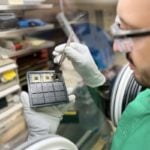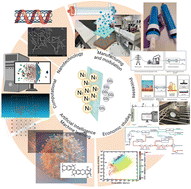Effects of Tail States in Cs2AgBiBr6 Double Perovskites on Solar Cell Performance: A Temperature‐Dependent Study of Photovoltaic External Quantum Efficiency, Open‐Circuit Voltage, and Luminescence
Advanced Energy Materials, EarlyView.

The impact of tail states on Cs₂AgBiBr₆ solar cell performance is investigated through temperature-dependent photovoltaic and luminescence measurements. A strongly temperature-dependent Urbach energy reveals high dynamic disorder. Tail-state excitation lowers the open-circuit voltage and induces unquenchable luminescence. By correlating charge extraction with photoluminescence quenching, this study provides insights into recombination pathways limiting these lead-free perovskite solar cells.
Abstract
Cs2AgBiBr6 double perovskites have been investigated as a lead-free alternatives to lead-based perovskites. However, despite promising features such as high luminescence lifetimes, solar-cell efficiencies and the open-circuit voltage still remain too low. Various spectroscopic studies suggested multiple reasons such as a fast relaxation into localized self-trapped excitonic and polaronic states. However, it remains unclear to what extent the suggested processes are the culprit for the low device performance. In this study, full devices are characterized as a function of temperature, focusing on highly sensitive measurements of tail states. In the spectral response, a strongly-temperature-dependent Urbach energy is identified, indicative of high dynamic disorder. The current generated from the excitonic absorption becomes only limiting at lower temperatures with an activation energy of 0.15 eV. Analysis of light-, temperature- and voltage-dependent photoluminescence (PL) indicates that charge extraction correlates with PL quenching and PL does not originate from geminate pairs. The bandgap deduced from temperature-dependent open-circuit voltage is found at 2.0 eV, coinciding with the PL peak. In contrast, tail-state excitation leads to lower open-circuit voltage and luminescence that cannot be quenched with voltage. Having identified the importance of tail-state features, the methodology might assist in optimizing materials and devices for enhanced efficiency.

























































































































































